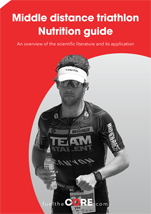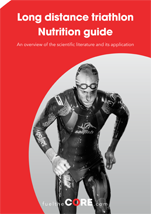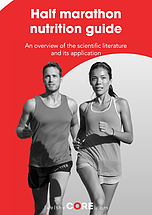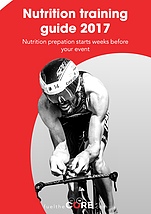Cycling nutrition guide
An overview of the scientific literature and its application.
Although nutrition is without doubt one of the most important aspects of race preparation, athletes typically spend far more time thinking about training than about nutrition. In road cycling and mountain biking (events that often last longer than 2 hours), nutrition can mean the difference between winning and not even finishing. Athletes who did not have a great ride or race often blame nutrition: they ran out of energy, became dehydrated or experienced stomach problems. They ingested too much, or ingested too little. They tried new products they had not used in training, and so on. This guide will give you the knowledge you need for a successful nutrition strategy. You can use the CORE Nutrition Planning tool to get a detailed personalized nutrition plan for your event.
Carbohydrates are the performance fuel
The body uses two main fuels: carbohydrate and fat. Fat is the primary fuel for less intense exercise (low to moderate intensity: often referred to as aerobic) while carbohydrates are the primary fuel for intense exercise moderate to high intensity). Carbohydrate can deliver energy much faster to the muscles than fats. Thus, carbohydrates are the performance fuel, and fat is like “diesel”, important for longer distances at lower pace.
The body has stores of both fuels, but unfortunately the stores for carbohydrate are much smaller than those of fat. Even the leanest athlete has sufficient fat to sustain the longest races at moderate intensity (thousands of grams of fat). The typical athlete will also have 500-800g of carbohydrates stored in muscle glycogen and liver glycogen (a small fraction versus fat stores); this is enough to fuel 2-3 hours of intense exercise.
Most endurance athletes are familiar with “bonking” or “hitting the wall”; this is the point when carbohydrate stores become depleted, usually around 2-3 hours into an event. At this point the athlete has only fat for fuel and intense performance cannot be maintained (unless carbohydrates are consumed). There are a few simple strategies that can delay or completely prevent this from happening. These strategies are making sure that you start with optimal muscle glycogen stores and liver glycogen stores and fueling during the ride or race (using drinks, gels and/or solid foods).
Carb-loading
In order to start a race with optimal glycogen stores it is important to eat carbohydrate-rich in the day or days before the race (usually while also reducing training, which uses glycogen stores). Traditionally consuming additional carbohydrates has been called carbo-loading. Consuming a little more carbohydrate than normal at the expense of some protein and fat will ensure that you are filling up your muscle glycogen stores, without gaining weight. Carbo-loading seems to get confused sometimes with overeating (eating as much as possible). Good sources of carbohydrate include pasta, rice, potato and bread. Extreme supercompensation diets such as those used in the 1970s are not necessary.
Breakfast
When you wake up in the morning the liver is virtually depleted of glycogen; the body uses up the liver glycogen through the night. Because the liver provides carbohydrate to maintain your blood sugar and prevent hypoglycemia (low blood sugar) during your event, it is essential to make sure you replenish liver glycogen. This is why breakfast is so important; breakfast replenishes liver glycogen stores. A good pre-race breakfast includes 100-200 grams of carbohydrate in the 3-4 hours before the start of your event. Some athletes find it difficult to eat before a race; they could benefit by getting their carbohydrates from drinks. Athletes who experience stomach problems frequently should avoid breakfasts that are high in fiber, fat and protein. Individuals very prone to developing gastro-intestinal problems may also want to avoid milk products (or use lactose free products).
Good carbohydrate sources for race day
- Refined grains (white rice)
- cooked cereals
- corn/rice based cereals
- white bread, bagels (no seeded breads)
- pancakes
- cooked veggies (no seeds)
- cooked potatoes
- ripe bananas
- cooked fruits, applesauce/fruit blends
- lean meat
- rice cakes
- honey
- syrup
- pulp-free juice
Nutrition just before the start
In the 15-30 minutes before the start you can continue to top up liver glycogen stores. We recommend 20-30g (80-120 kcal) of carbohydrate with 90-180ml (3-6 fl oz) of water. Because food and drink will sit in the stomach for a while and absorption takes time, most of the carbohydrate you ingest at his time will become available during the first part of the event. So, anything that is ingested shortly before the start is part of your nutrition during exercise. What foods are best is a matter of personal preference, but gels and chews are very commonly used. Make sure you also practice this in training.
Nutrition during the race
Endurance cycling nutrition requires a bit of planning. It is important to study what is available on course and develop a plan that takes into account foods and drinks you will collect on course versus foods and drinks you will have to bring yourself. During longer events your target carbohydrate intake should be higher than during shorter events. In events over 2 hours, athletes can benefit from an intake of roughly 60 grams of carbohydrate per hour. Do not try this for the first time in your event! You should transition from your current fueling levels towards 60g/h during training. Your gut will get used to this very quickly. Again, what foods and drinks are best is a matter of personal preference. The target of 60g/h can be achieved with many different combinations of water, sports drink, gels, chews, bars, and regular foods.
General
It is important to realize that any foods (bars, gels, chews or other) needs to be ingested with sufficient water to make sure gastric emptying is fast and no stomach problems develop.
Carbohydrate from solid foods
Solid foods usually provide more carbohydrates per unit of weight and are therefore a very effective energy source to carry. Bars typically deliver 30-60g of carbohydrate and come in many different flavors and with varying levels of fat, fiber and protein. It is recommended to select energy bars that are low in fat, fiber and protein as these ingredients will slow down gastric emptying and may contribute to stomach problems. Solid food is great in preventing an empty feeling in the stomach that many athletes experience during later stages of a race. One drawback of bars, however, is that they can be difficult to chew while racing. A second drawback is that bars generally contain more carbohydrates than should be consumed at one instance; this means a bar would need to be carried for some period while being consumed in smaller bites. For these reason, some athletes prefer to get their carbohydrates from gels or chews.
Gels
Gels are a compact form of energy. A small volume of fluid with a relatively large amount of carbohydrates. Gels typically deliver 20-25 grams of carbohydrates and come in many different flavors. Gels may be caffeinated or non-caffeinated.
Chews
Chews are the middle ground between bars and gels. They are more solid than gels and are usually easier to consume than bars: easier to chew and come in single bite pieces. Chews generally are 6-10g per piece, so 3 pieces typically is close to a gel.
Carbohydrate drinks
Carbohydrate drinks typically contain carbohydrates in concentrations of 6-7%. This means that the drink contains 60-70 grams of carbohydrates per liter of fluid. A regular sports bottle of 600ml (20 oz.) will therefore deliver roughly 35 grams of carbohydrate. A sports drink also contains some sodium (and other electrolytes) which can be beneficial for the absorption of fluid (as we will see under hydration).
Caffeine and performance
Many athletes use caffeine before or during a race to boost their performance. This practice is indeed supported by scientific evidence although there may be individual differences in tolerance and perception. Studies have demonstrated that relatively small amounts of caffeine are required to give optimal effects (3mg per kilogram body weight; 200mg for a 70kg person).
Because caffeine absorption takes 30-90 minutes, timing of caffeine is important. Studies have shown that caffeine ingested late in a race can still provide benefits. What works best is going to be highly individual and best established by trial and error. There are many different ways to deliver caffeine: gels, colas, energy drinks, and coffee. The caffeine consumption for a race should conform to a person’s normal intake of caffeine. It is generally recommended not to exceed a daily intake of 400 mg caffeine from all sources.
| Caffeinated gels | 25-50mg per gel |
|---|---|
| Cola drinks | 40-50 mg per 355 ml can |
| Energy drinks | 50-100 mg per 250 can |
| Espresso | 80-100 mg per cup |
Dehydration
Another cause of fatigue during endurance cycling is dehydration. In order to make sure body temperature stays within acceptable limits and we don’t overheat, we sweat. The harder we ride, the more heat is produced and the more we need to sweat to stay cool. In hot conditions it is even more important because sweating may be the only way we can cool down our bodies. When we lose too much sweat and become dehydrated, it becomes harder to maintain our body temperature. Some degree of dehydration is unlikely to be a problem but once you start to lose 3% or more of your body weight or more, performance may be affected.
In order to prevent dehydration, it is important to start a race hydrated and maintain proper hydration throughout the race.
Before the race, drink at least 500ml the ~2 hours before the start; excess water will be eliminated through urine. Double check your urine color is pale.
During the event, your target for fluid intake should be such that you lose no more than 3% body weight. This will always mean consuming fluid at a rate that is below your sweat rate (the longer the race, the closer to your sweat rate consumption will need to be). Drink to thirst is a recommendation that works fine for the slower athlete. If you are going a bit faster it is better to go in with a plan.
It is wise to use the early parts of a race when the gastrointestinal tract is working fine to absorb both carbohydrate and fluid. Later in the race, even though you may be thirsty, the gut may not absorb as much. Don’t drink excessively, and use common sense. The goal should be to lose a little weight (1-2 kg) at the finish line. Athletes who want to be a little more prepared can work out how much they will sweat in the conditions of the race and use this to guide their drinking. If you want to find out how to best measure your sweat rate visit http://bit.ly/sweatrater. Don’t drink excessively, and use common sense. All athletes definitely need to avoid weight gain, which clearly would be a sign of drinking too much, and that could lead to a dangerous condition called hyponatremia.
Don’t forget that good hydration starts before the race, and hydrate well in the days leading to your race.
If certain symptoms have arrived, there are some possible remedies during the race. It is important to note that when bloating occurs and fluids seems to accumulate in the stomach there is no point ingesting more fluids. Reducing the intensity a little and giving the stomach some time to pass fluid on to the intestine for absorption and relieve bloating.
Special considerations for multi-day events
For multi-day events, the most important additional consideration is recovery fueling and hydrating at the end of each day. It is important to start hydrating and as soon as possible after the ride and that you take on board carbohydrate at a rate of 60-70 grams per hour. If you can have a meal not long after finishing there is no need to take recovery drinks and shakes. You can get carbohydrate and protein from normal foods. If it is difficult to get a good meal, recovery shakes are a great practical solution.
Special considerations for non-race events
Many non-race events such as Gran Fondos or charity rides include major lunch breaks midway through the ride in addition to ample aid stations. Planning nutrition for these non-race events is slightly different from planning for a race, and you will need far less on the bike but a race plan is still the right place to start.
Lunch
Lunch breaks can be a great time mid-ride to recover, re-nourish, and socialize. But the lunches can also likely result in far more intake than might otherwise happen in a race. A simple approach to planning around lunch is to first plan your nutrition as if lunch weren’t available (i.e. as if it were a race). Then, eat lunch as you like and expect that lunch nutrition should cover nutrition needs for the next 60-120 minutes after lunch. Ignore any food items in your plan that are scheduled 60 min after the lunch, but continue to follow your plan after that.
Eating at Aid Stations / Rest Stop vs eating while riding
During a race, carbohydrate and fluids are generally consumed while riding. In Gran Fondos and charity rides, it’s quite common for participants to stop for nutrition. CORE will plan nutrition as if it’s being consumed while riding as in a race. If you prefer to consume nutrition at rest stops, just plan for this by putting these food items on your plan at the aid stations.
Training
One of the most important aspects of preparation is “training your race nutrition”. Nutritional preparation should not start when you are walking around at the expo the day before your event! It should start at least 6-10 weeks before the event and is important during your entire preparation phase. Training will always involve a mix of hard and easy; same is true for nutrition. On easy days where quality of training is not so important and where you may purposely want to train your body to use fat as a fuel, you will consume little or no carbohydrate (“training low"). On other days that are hard, where quality is important and where you want to train your body to perform just like you will in a race, it is a good idea to follow your race plan.
If you want a more personalized and more detailed nutrition plan, please visit CORE Nutrition.
Top tips
- Don’t experiment with new products on race day.
- Use the same nutrition products for at least 6 weeks prior to the race.
- Don’t be afraid to listen to your gut and when fluids are not emptying from your stomach reduce the intensity temporarily. You will benefit from this later in the race.
- Hydration during the race is important, but make also sure you don’t start the race dehydrated
- Plan your breakfast on race day well in advance and make sure it is available for you on race day. Don’t just show up for breakfast in a hotel on race day without checking.
Reading list
- Baker LB, Jeukendrup AE. Optimal composition of fluid-replacement beverages. Compr Physiol. 4(2):575-620, 2014.
- Burke LM, Hawley JA, Wong SH, Jeukendrup AE. Carbohydrates for training and competition. J Sports Sci. 29 Suppl 1:S17-27, 2011.
- Jeukendrup AE and Gleeson M. Sports nutrition 2nd edition Human Kinetics Champaign IL. 2010 (ISBN-13: 978-0736079624, ISBN-10: 0736079629)
- Jeukendrup AE. Nutrition for endurance sports: marathon, triathlon, and road cycling. J Sports Sci. 29 Suppl 1:S91-9, 2011.
- Jeukendrup A. A step towards personalized sports nutrition: carbohydrate intake during exercise. Sports Med. 44 Suppl 1:S25-33, 2014.
- de Oliveira EP, Burini RC, Jeukendrup A. Gastrointestinal complaints during exercise: prevalence, etiology, and nutritional recommendations. Sports Med. 44 Suppl 1:S79-85, 2014





